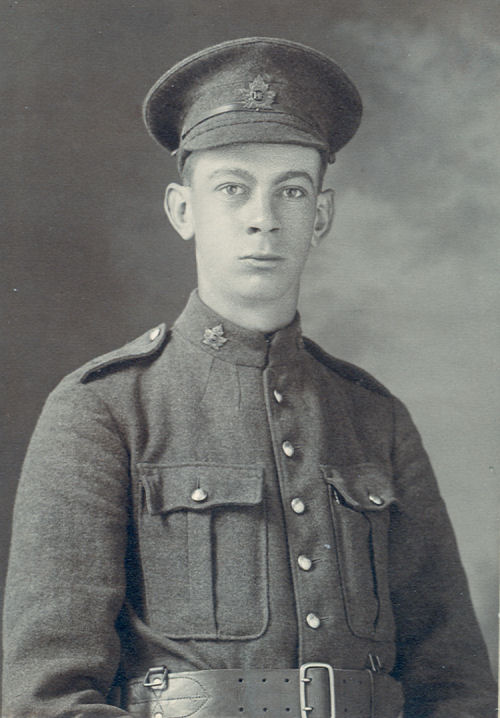
835648 Pte. Clarence McCabe was a farmer from the north shore of Hay Bay, near the town of Napanee, Ontario. He was born on June 23rd, 1891, and was the only son of Ashton and Martha McCabe.
On March 1st, 1916, at the age of 25, Clarence volunteered into the 146th Battalion, also known as the Frontenac Battalion, and given service number 835648. At attestation he was tall and thin, standing 6 feet 3½ inches tall and weighing 175 lbs. He volunteered with his 16 year old cousin, Reggie Brown, however Reggie was found out to be under age and discharged shortly afterwards.
After completing training with the 146th, Clarence left Halifax for England on September 26th, 1916, on the SS Southland and arrived there safely 12 days later. On November 30th, Clarence, along with 276 other men from the 146th, was transferred to the 4th CMR. He arrived in France on December 1st, which was a relatively good time as the winter of 1916-1917 was a period free from any major operations.
In February 1917, Clarence and the rest of, the 4th CMR were pulled out of the front lines to start 5 weeks of extensive training and preparation for the attack on the German stronghold of Vimy Ridge. The Ridge was thought to be impenetrable, as the French had tried for 3 years, with 150,000 casualties, and still had not been able to take it.
On April 9th, 1917, the 4th, with snow blowing at their backs, attacked the Ridge with rest of the 4 Canadian divisions. The 4th CMR had the objective of crossing 3 German trench lines and capturing a large wooded area called La Folie Wood, which was just beyond the crest of the Ridge. The 4th CMR had taken all of their assigned objectives by mid-afternoon on the first day, but it was not without significant cost, as 43 men were killed, 131 wounded and 19 were missing that day.
In the process of achieving their objective, the 4th CMR captured 250 German soldiers, 1 Colonel, 3 trench mortars and 4 machine guns. The Regiment was relieved on April 11th after 63 hours of holding the line in the most trying of weather conditions. For the Canadians, this was their first major victory of the war.
On May 26th the 4th was in divisional reserve in a part of the line known as Toronto Camp. It had been a bright and warm day and around 8:30 pm they were engaged in a baseball game. Clarence picked up a blind (unexploded) shell, which went off and killed him instantly. This accident was all the more tragic that day, in that 8 other men died:
Sgt. George Knowles all died immediately;
Pte. Bertie Traviss died the next day at no. 6. Casualty Clearing Station;
Pte. James Dunn survived until May 31st and
Pte. Edwin Payne died on June 18th.
10 others were wounded in the accident including Pte. Thomas Davy and Pte. Morley Gilbert. At least 6 of the casualties were from Clarence's home town of Napanee and all these men were likely close friends of Clarence's.
Clarence is buried in La Targette British Cemetery, Neuville St Vaast, Pas De Calais, France, and a picture of his headstone can be seen courtesy of the Maple Leaf Legacy Project website. Clarence's name is also on the Cenotaph in front of the Court House in Napanee and is remembered there along with Pte. Shurley Asselstine, Pte. Arthur Carroll, Pte. James Dunn and Pte. Charles Hartin.
Credit and many thanks go to Bryan Joyce for the above biography and image.
Bryan has written a book about Clarence McCabe's life, and this can be reviewed and bought via this link: Clarence McCabe - book
See also Lt. Guy Dingle for an uncannily similar though less fatal accident.